
- For 2-12 players
- Game of strategy
- Ages 7 and up

- For 2 8+ Players
- 15 minute playing time
- Age 14 and up
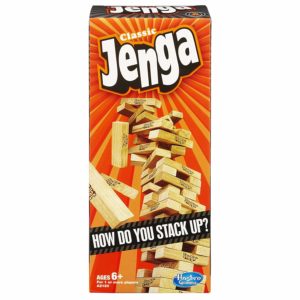
- For 1 or more players
- 54 Blocks
- Ages 6+
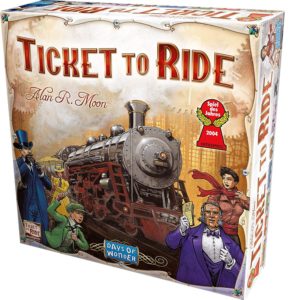
- For 2-5 players
- 30-60 minute playing time
- 225 Colored Train Cars
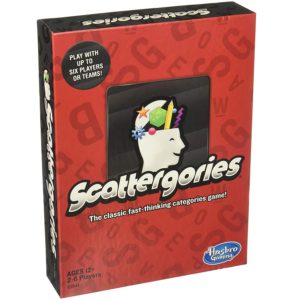
- For 2-6 players
- Fast-thinking game
- Ages 12+
Choose the Best Board Game for 5 Players
Customer’s Choice: the Best Rated Board Games for 5 Players
13 users answered this survey. Please help us improve this review!
Many people enjoy playing board games even as adults because it takes their mind off everyday life while being able to talk and interact with others in an entertaining setting. Board games for 5 players give everyone a chance to participate instead of only one player dominating play time (as often happens when there’s only two).
If you’re looking for the best board games for 5 players, there are certain things that you should consider before making a purchase decision.
It doesn’t matter if you’re a board game novice or expert, there’s always room for improvement when it comes to game night! Whether you’re looking for new games to add to your collection or just want some pointers on how to make the most of your next gathering, this guide is here to help.
A few board game experts have compiled a list of the best five-player board games and provided reviews from other players in our community so that you can find the perfect match for you, your friends and family members.
Table of Contents
Original SEQUENCE Game – the Editor’s choice!
 Sequence is an ingenious game that challenges even adults, and engages their brains as they try to connect five consecutive cards. With the use of a clever board, it becomes easy for children to play too!
Sequence is an ingenious game that challenges even adults, and engages their brains as they try to connect five consecutive cards. With the use of a clever board, it becomes easy for children to play too!
This board game challenges all of your skills as a player, but incorporates exciting yet easy-to-learn gameplay that will develop STEM skills along the way. You’ll think on your feet and play a card from your hand while placing a chip on a corresponding space on the game board – when you score five in a row, it’s time for celebration.
Suitable for 2-12 players and perfect as a family’s night in activity. A mixture of luck and strategy produces the right recipe for a perfect night – why not give Sequence a try?
Pros
- Great for 2-12 players;
- Nice strategy game;
- Easy for children and challenging for adults;
- Helps to build STEM skills;
Cons
- Small parts can be dangerous for kids younger than 6;
- No a metal box version;
- Poor quality;
The Original Sequence Game is easy enough for children, and challenging for adults! This exciting game will develop your child’s STEM skills like strategy. Great family fun that no one can get enough of!
Clue Board Codenames Game – the best for easy rules!
 No one can resist a little friendly competition. Giving that competitive edge back to your game night is when you play! Everybody will be slapping the table in laughter after they see how fun this social discovery game can be.
No one can resist a little friendly competition. Giving that competitive edge back to your game night is when you play! Everybody will be slapping the table in laughter after they see how fun this social discovery game can be.
The Codenames Game is easy to learn and engineered for challenges, so it’s perfect for any get together. Don’t let all those clever codenames slip away- keep them safe with our durable and reusable cards of high quality paper made for over 100 games. This would make an excellent gift no matter the occasion or people you visit it upon!
Pros
- Fun gameplay;
- Easy rules;
- Good to play with family and friends;
- Great for team building;
- Good gift idea;
- Up to 8 players;
- Good quality;
Cons
- Small parts are dangerous for little kids;
- Some users claim the gameplay is slow;
Clue Board Codenames Game is a fun game for any type of get together. It’s easy to learn, and something you can play with your friends or family!
Jenga Classic Game – the best for parties!
 The iconic Jenga game has won the “Toy of the Century” award. It starts with just a tower and 54 blocks, but you are building your way to victory by carefully stacking blocks in an attempt to avoid adding too much weight, which will lead to the inevitable fall.
The iconic Jenga game has won the “Toy of the Century” award. It starts with just a tower and 54 blocks, but you are building your way to victory by carefully stacking blocks in an attempt to avoid adding too much weight, which will lead to the inevitable fall.
It sounds easy but looks are deceiving: each turn only increases stakes with precarious stacks, multiple blocks pulled at a time, and closer steps towards that inevitable loss. Challenge yourself or play with friends; win by being the last player standing literally!
With its simplistic gameplay, overwhelming strategies, and thrilling suspense – there’s no doubt that it’s a favorite among age groups six years old up to adult.
Pros
- Good for the age range from 6 years;
- Easy to learn;
- Solid blocks;
- Requires skill, luck and strategy;
- Great for parties;
Cons
- Outdated packaging;
- Some blocks are slightly asymmetrical;
Essentially the first, original game that you can count on to provide just about infinite hours of fun. There’s nothing more than wood and a basic set of rules needed for a Jenga Classic Game – all it takes is one well-timed pull and the whole tower will tumble!
Ticket to Ride Board Game – the best for a whole family!
 Family and friends will want to play this fast-paced, strategic, and easy-to-learn board game together for hours on end. Connect iconic North American cities across a map of the 20th-century USA while building your rail empire with ease using instant online gameplay.
Family and friends will want to play this fast-paced, strategic, and easy-to-learn board game together for hours on end. Connect iconic North American cities across a map of the 20th-century USA while building your rail empire with ease using instant online gameplay.
Intuitive design makes it kid-friendly, but adults will also enjoy hours of entertainment thanks to diverse strategies including “blockers” which give you the best defense against tricky opponents like other players or tough levels with short deadlines.
You can play as young as 8 years old and have it last up to 60 minutes long – depending on how many players there are!
With elegantly simple gameplay that can be learned in under 15 minutes. Ticket To Ride Board Game offers endless replayability whether it’s your first time building a rail empire or an N-th time you are playing!
Pros
- Designed for 2-5 players;
- Average playtime is 30-60 minutes;
- Fast-paced gameplay;
- Interesting gameplay;
- Easy to learn;
Cons
- The board is asymmetrical;
- Instructions are terribly written;
On family game night, Ticket to Ride is the gem that sparkles and shines right beneath your nose. This fast-paced strategy board game will keep you and your siblings or friends entertained for hours with interesting routes to create across America on a train map.
Hasbro Gaming Scattergories Game – the best for quick gameplay!
 Do you already have the world’s best Scattergories game? Prove it to your party guests. There are more than 3,500 different combinations for everyone to choose from. Let your friends and family build their own categories!
Do you already have the world’s best Scattergories game? Prove it to your party guests. There are more than 3,500 different combinations for everyone to choose from. Let your friends and family build their own categories!
For a good time, play in teams of 3-6 or as individuals to find answers within less than 10 seconds. You may never know when critical thinking has been so much fun again!
There are thousands of combination possibilities so this will never get old. Impress your friends and family while challenging their vocabulary skills and quick thinking with over fifty unique categories that cover a variety of things from sports events to inventions created by women.
Pros
- Fast-thinking categories;
- Addictive;
- Up to 6 players in each team;
- More than 3,500 category combinations;
Cons
- Pricey;
- Red case is flimsy;
- The cards have too small writings;
The Buyer’s Guide
What is the most fun board game?
The most fun board game has a subjective answer. What one person finds entertaining, another may not. However, some games stand out from the crowd in terms of excitement and enjoyment for every player involved in gameplay.
There are many good choices when it comes to finding the best board games for five players with plenty of variety across style, genre and playtime requirements. Many popular titles are reissued each year as new editions or special versions designed specifically around group play at home or family vacations like:
- Carcassonne;
- Codenames;
- Jenga;
- Settlers of Catan;
- Pandemic (Evolution);
- Small World;
These games can keep everyone engaged with fun mechanics, in addition to accessible game sessions lasting around an hour or less depending on player count. While they all have unique gameplay elements appealing to different interests like building cities in Carcassonne or fighting off diseases as part of Pandemic‘s cooperative experience, one common theme is keeping everyone involved throughout each turn no matter who ends up winning at the end of playtime.
It may sound simple enough but it can make or break group satisfaction when playing any tabletop board together especially if you’re trying to keep five people engaged with each other for 90 minutes at a time.
What is the most boring board game?
Monopoly is probably the most boring board game for five players. It can be slow and long, taking a few hours to complete. The more people playing Monopoly at one time, the longer it will take because you have less money and resources per player over all of them combined. This means that turns are going to last longer in general with fewer opportunities for rapid deals or dice rolls that change things quickly.
On top of this every turn has much more downtime than any other games listed here (the exception may be Risk). You do not play as many cards on your turn so there are often very large gaps where nothing happens – especially if two/three players share an action space! Even worse, you start building properties they act as a blocker to other players so you can find yourself stuck unable to make any progress on your own strategy.
Board game types and genres for 5 players:
- Party games. These kinds of games are often very social, with lots of laughing, drinking, leaning across the table to assist another player (even when that may not strictly be allowed by the rules) and more than occasionally wandering eyes on attractive members of the opposite sex (or same if you like to play with a different preference). They are great fun, but usually light and simple.
- Family games. These games should work for any age group from about 6 or 7 years and up. There is no adult content whatsoever in these games and they do not take themselves too seriously. Children have just as much chance to win as adults. The humor is typically dry, non-offensive and suitable for the whole family to enjoy together.
- Eurogames. These are the “serious” strategy games now played at a table rather than on a computer screen; featuring high-quality components, clever mechanics that require thinking ahead several moves at once, no luck (or very little luck) involved in winning and often with a high degree of player interaction. They are a great way to learn ‘real’ strategy and thus much more rewarding in the long term than playing against AI opponents on a computer, which is designed to give you an easy win every time.
- Area control. The player who has the most pieces in a location is said to have “control” over that area. This mechanic involves players moving and placing their own tokens, which are then used to generate resources or points. The player who has the most pieces in a location is said to have “control” over that area. This mechanic involves players moving and placing their own tokens, which are then used to generate resources or points.
- Auction/Bidding. Auctions can occur during setup of the game where players bid on turn order (see above), unique powers for components (e.g., special abilities or new cards) or even temporary control of certain locations/resources on the board; sometimes they take place during gameplay, with players bidding goods or perhaps victory points to gain something they really want.
- Deckbuilder. A deckbuilding game is one in which the players typically begin with a very limited selection of cards, and expand their options as they play by purchasing new cards from a large pool that are then added to their discard pile (to be shuffled into their deck on a later turn).
- Dice rolling. These games use dice to create randomness, much like Yahtzee. In these games, players are usually allowed to re-roll dice sometimes several times.
- Cooperative. Cooperative board games challenge a group of players against the game itself (often represented by a monster, or AI opponent). In cooperative games, all members of the group win or lose together as opposed to individually, and if one player achieves the goal set for that players’ particular game variant then they have “saved the day” and everyone else can celebrate!
- Wargame. A wargame is a strategy board game that deals with military themes and combat, such as conflicts in the historical past or future. The player directly controls only a single unit/group of units (such as an army).
- Abstract games. Some games don’t really have direct counterparts with other genres: Hive, for example, shares some similarities with chess but has no theme at all; while Go is considered to be at least partially derived from the birth of civilization in Eastern Asia. These games are abstract, i.e., they do not attempt to represent events or strategy based on any kind of real world situation or previous work. They often require high levels of abstraction and focus purely on the mechanics involved.
FAQ
What are the rules to the game Sequence?
The game of Sequence should have a deck of cards where all the number cards are removed, and only the sequence cards remain. The rules to playing Sequence is as follows: deal each player ten cards face down. The remaining stack decides the point value for that player’s hand. Play starts with the dealer and goes clockwise around the table.
Each turn consists in drawing one card, and matching its numerical value by placing it against a card from your hand that connects either vertically or horizontally (connecting numbers must be consecutive). For example, if your starting hand contained 2 fours, then you could place them next to each other to match up (4-5-6), but you cannot place an 8 on top of an 8. For each sequence you match, you are awarded the point value of that stack.
Is Sequence a good game?
Sequence is a good board game that has solid gameplay and nice components to boot. It plays well with 2 players, but the rules and strategies for games up to 5-6 players can be quite different from 2-player games as players will need to cover their side of the field while also preventing opponents from doing the same. In addition, you have neutral pieces that add both depths in strategy (you can use them offensively and defensively) and aesthetics.
How do you play Codenames?
Codenames is a social word game with a simple premise and challenging game play. Two rival spymasters know the secret identities of 25 agents. Their teammates know the agents only by their codenames. The teams compete to see who can make contact with all of their agents first. Spymasters give one-word clues that can point to multiple words on the board. Their teammates try to guess words of the right color while avoiding those that belong to the opposing team. And everyone wants to avoid the assassin.
How many guesses do you get in Codenames?
The correct answer is 2. You get two guesses in Codenames, or as they like to call them: “clues”. There’s a few reasons why the guess limit is set at 2. The biggest being it makes the game more fun! By limiting players to only 2 guesses (with an option of passing for a clue) it accelerates the pace of play making things very tense for both spies & spymasters.
What are the rules for playing Jenga?
The object of the game is to remove one block at a time from a tower constructed of 54 blocks, and then place it on top without collapsing the structure.
Jenga requires three or more players. Each player takes a turn removing one block from any level of the tower except the one below the incomplete top and puts it on the topmost level to complete it. A move consists of taking one and only one block from any level except the one with the incomplete top and placing it on top.
Only one hand should be used at a time when taking blocks out of the tower; both hands should be used together when putting them back or they will not count. Blocks moved during a game must have been previously exposed by an opponent’s move, but need not be part of that opponent’s game (they can belong to your other opponents). It is permissible to other levels while taking a block from the top level.
If a player touches one of the pieces or places their hand on the tower, he or she must withdraw his or her hand and place it back at his or her side. If a piece falls off the structure, it returns to its starting position as part of a move in which no block is removed from the stack and no other violation takes place.
The game ends when the tower falls in an earthquake (or by choice), if any piece falls from the tower except those played during moves, or if an incorrect block is touched while taking it out of the tower. Players may touch other levels but may not shake them in order to disturb other players’ pieces already on those levels.
The winner is either the person who successfully removes and places the final block or the last player not to have caused the tower to fall.
What happens if 2 blocks come out in Jenga?
There are 2 options:
- The block that came out will fall. If there is no one holding Jenga tower, the tower itself falls as well;
- There is a possibility that blocks other than the two blocks that fell are also pulled off by the weight of the falling block;
If three or more blocks come out at once, it stops being Jenga and becomes an accident. As you continuously remove 2 blocks at a time, removing 3 or more sends the game over. This means that if you keep pulling and all of sudden get greedy for clearing too many blocks to make yourself win faster, you will ultimately lose the game instead because pulling out more than 2 blocks at once is against the rules.
You can only remove one block at a time. If you pull out more than 2 blocks, the game ends and becomes an accident. If you are greedy for winning by getting rid of some extra blocks in order to make it faster, you will ultimately lose if 3 or more come out as a result of it. This is because pulling out more than 2 blocks at once isn’t permitted in Jenga‘s rules.
Is a Ticket to Ride worth it?
Yes. Ticket to Ride is a very good board game that has survived the test of time and remains popular. It is one of the best games in its class, with excellent production values, fun gameplay, and easy rules. The game starts simple, but gradually introduces more options to increase player interaction. Multiple strategies can maximize your chances of winning. The game plays well with two players and all the way up to five, although experts would recommend only playing with four or more at maximum for a longer and more fun experience.
Ticket to Ride is not perfect, however. It has some minor flaws that affect the overall gameplay, such as luck-based card drawing, loss of control of your fate when it comes to routes occupied by opponents’ tokens, an uninteresting endgame, lack of player interaction in the early part of the game, and some issues with balance.
Is Ticket to Ride a fun game?
Yet despite its apparent simplicity Ticket to Ride has surprising depth in strategy for such a small-sized board game. The strategy is really enhanced by adding cards with special abilities (or “personality cards as they’re called) which add another element of bluffing, bets, or surprise to the mix – all this in a 30-minute board game?
Ticket to Ride is a great game and the only minor problem players might have with it is that some games seem to drag out unnecessarily – there’s no in-built finish line as such so if you’re playing with particularly slow folk you might find yourself growing increasingly impatient.
Ticket to Ride is an award-winning fun family board game that has been around for 10 years. It is easy to learn, yet hard to master, and now it supports up to 5 players. Easy as matching colors but requires strong strategic moves. Ticket to Ride will have you hooked in no time!
How do you play Scattergories at home?
It’s very easy. You pick a category and everyone gets a minute to think up things that fit the category. Then each person has a minute to write all his or her answers down on a piece of paper. After the time is up, everyone reads all their own answers aloud and then votes for which answer they think was best – here you can vote for yourself or others if you wish. The person with the most points wins.
How long is a game of Scattergories?
Scattergories is a game that can last anywhere from 30 minutes to a few hours, depending on what players consider to be the end of the game. The official rules state that one round should take about 30 minutes (with no more than 3 rounds per game). A game with 5 or more people will most likely go over this time limit, especially if players are having difficulty coming up with answers. Three-pointers may also take some extra time.
The easiest way to keep track of when the game has ended is by keeping an eye on the clock and announcing “Time!” whenever you think it’s appropriate. If you’re playing just for fun, feel free to stop playing when all the game seems done. Otherwise, keep playing until all players agree to end the game.
Shake up family game night with the fast-thinking, Hasbro Gaming Scattergories Game! With over 3,500 possible combinations, there’s something for everyone!
So, you have an upcoming party between a group of 5 friends, family members or colleagues. And you want to deliver as much fun as possible. I am perfectly aware of this challenge and ready to assist you with this choice. Below you will find my criteria for buying the best board games for 5 players.
Features of the best board games for 5 people and more
Playability is an important feature that makes people interested in playing the same game for the second, third and following times.
Since we are talking about the choice of board games that strengthen good relationships among friends, family members or colleagues, I recommend choosing fun but not competitive games. So I wouldn’t consider Mafia. Often people transfer their relationship in such games, so usually such games do not contribute to the fun, but, on the contrary, heat the situation.
Cooperative board games for 5 players or more make the participants play not against each other but together. It is important for each team to work together, to develop a common strategy, to help each other in every way possible to win the game. There are games where there are no teams – either everyone wins or loses. Hooray for teambuilding if you pick the board games for 5 colleagues! A coop game for 5 players should not be complicated and must have short but intense gaming sessions.
Incredible board games for 5 players:
- Sequence is a great strategy game for 2-12 players aged over 7 years and more;
- Codenames is a 15-minute game, for the participants aged over 14 years and more;
- Jenga is a classic game with 54 blocks to build a high tower. It is great for kids and adults;
- Ticket to Ride offers 30-60 minutes of awesome and funny gameplay with 225 colored trains;
- Scattergories Game is a fast-reaction game for 5 players aged over 12 years and more;
Have you ever heard of Ticket to Ride game? Watch the video tutorial explaining how to play these rules and have fun. What board games do you pick to play with family and friends? I’m really interested in your feedback and will answer everyone who will offer interesting picks for this review and the following ones. Thanks for choosing Jenga-Game.Com!
Video Tutorial: How To Play Ticket to Ride Europe
Final thoughts
If you’re looking for more advice on how to make game night even better, don’t forget to check out this guide. A few experts have compiled a list of the best five-player board games and provided reviews from other players in the community so that you can find the perfect match for your next gathering.

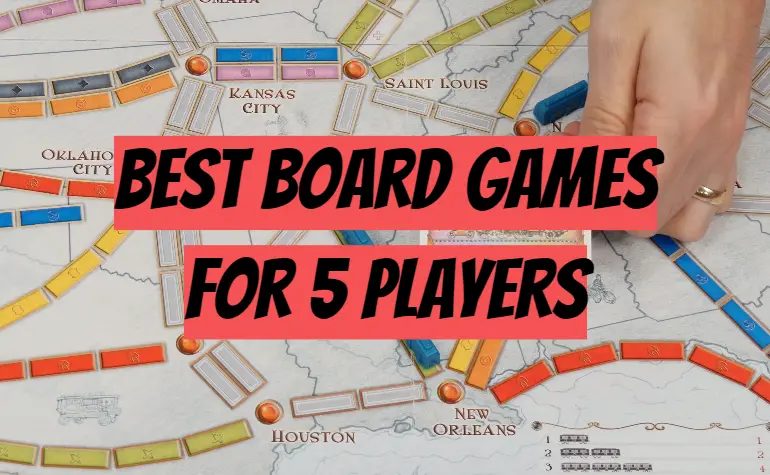

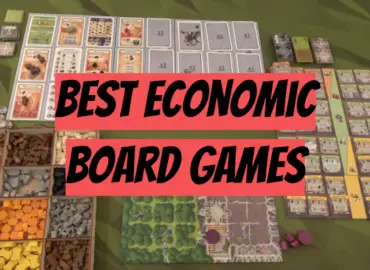


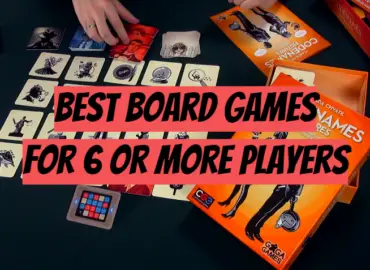
Thank you so much for creating this wonderful article! I’ve been looking around the web for the best 5 player board games and you would be surprised how hard it is to actually find a well thought out list/article. I haven’t heard of a couple of games in this list, but am extremely thrilled to check them out.